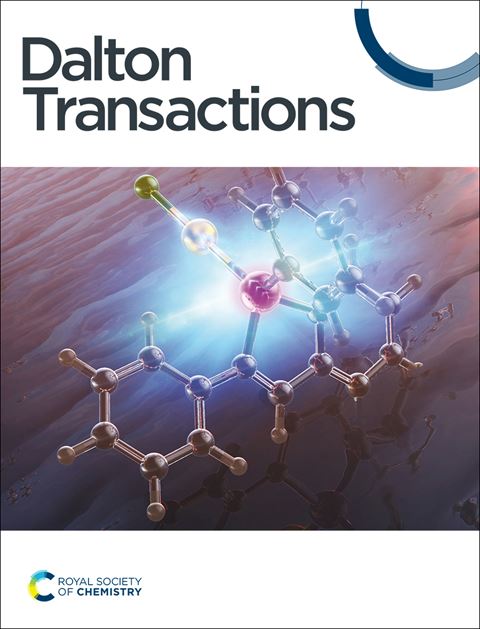氨基基镍配合物在气助法和光催化中的应用
IF 3.5
3区 化学
Q2 CHEMISTRY, INORGANIC & NUCLEAR
引用次数: 0
摘要
新的镍(II)配合物被研究作为气体辅助方法的潜在前体:化学气相沉积和聚焦电子或离子束诱导沉积,这是生产纳米材料的技术。本文报道了具有全氟取代基的脒-羧酸盐[Ni2(NH2(NH)CRf)2(μ-O2CRf)4] (Rf = CF3, C2F5)和咪酰酰胺[Ni(NHC(CF3)NC(CF3)NH)2]配合物的常规和机械化学“绿色”合成及其性质。红外光谱、电子冲击质谱和密度泛函理论计算证实了双核氨基羧酸盐和单核氨基酰胺配合物的形成。此外,利用单晶x射线衍射分析了[Ni(NHC(CF3)NC(CF3)NH)2]·(NH4)(CF3CONH)·(CF3CONH2)·H2O的结构。利用热分析和升华实验研究了所研究化合物的热稳定性和挥发性。结果表明,[Ni2(NH2(NH)CC2F5)2(μ-O2CC2F5)4]和[Ni(NHC(CF3)NC(CF3)NH)2]在10−2 mbar压力下在358 ~ 423 K范围内升华。配合物的电子冲击质谱分析和显微镜研究(SEM/EDX和TEM/EDX)表明[Ni2(NH2(NH)CC2F5)2(μ-O2CC2F5)4]对低能和高能电子最敏感。对于这种化合物,使用化学气相沉积(CVD)工艺在硅、玻璃和二氧化钛纳米管上生长镍基材料。动力学试验表明,用镍修饰二氧化钛纳米管增强了该材料光催化降解亚甲基蓝的活性。所得结果表明所选化合物可能是一种有前途的气相沉积技术前驱体。本文章由计算机程序翻译,如有差异,请以英文原文为准。

Nickel complexes based on amidine for applications in gas-assisted methods and photocatalysis
The new nickel(II) complexes were investigated as potential precursors for gas-assisted methods: chemical vapor deposition and focused electron or ion beam induced deposition, which are techniques to produce nanomaterials. We report the conventional and mechanochemical ‘green’ synthesis of amidine-carboxylate [Ni2(NH2(NH![[double bond, length as m-dash]](https://www.rsc.org/images/entities/char_e001.gif) )CRf)2(μ-O2CRf)4] (Rf = CF3, C2F5) and imidoylamidinate [Ni(NHC(CF3)NC(CF3)NH)2] complexes with perfluorinated substituents and their characteristics. Infrared spectroscopy, electron impact mass spectrometry, and density-functional theory calculations were used to confirm the formation of dinuclear amidine-carboxylate and mononuclear imidoylamidinate complexes. Additionally, the structure of [Ni(NHC(CF3)NC(CF3)NH)2]·(NH4)(CF3CONH)·(CF3CONH2)·H2O was solved using single crystal X-ray diffraction. Thermal stability and volatility of the studied compounds were investigated using thermal analysis and sublimation experiments. These results show that [Ni2(NH2(NH
)CRf)2(μ-O2CRf)4] (Rf = CF3, C2F5) and imidoylamidinate [Ni(NHC(CF3)NC(CF3)NH)2] complexes with perfluorinated substituents and their characteristics. Infrared spectroscopy, electron impact mass spectrometry, and density-functional theory calculations were used to confirm the formation of dinuclear amidine-carboxylate and mononuclear imidoylamidinate complexes. Additionally, the structure of [Ni(NHC(CF3)NC(CF3)NH)2]·(NH4)(CF3CONH)·(CF3CONH2)·H2O was solved using single crystal X-ray diffraction. Thermal stability and volatility of the studied compounds were investigated using thermal analysis and sublimation experiments. These results show that [Ni2(NH2(NH![[double bond, length as m-dash]](https://www.rsc.org/images/entities/char_e001.gif) )CC2F5)2(μ-O2CC2F5)4] and [Ni(NHC(CF3)NC(CF3)NH)2] sublimate over a range of 358–423 K under 10−2 mbar pressure. Electron impact mass spectrometry of complexes and microscopy studies (SEM/EDX and TEM/EDX) reveal that [Ni2(NH2(NH
)CC2F5)2(μ-O2CC2F5)4] and [Ni(NHC(CF3)NC(CF3)NH)2] sublimate over a range of 358–423 K under 10−2 mbar pressure. Electron impact mass spectrometry of complexes and microscopy studies (SEM/EDX and TEM/EDX) reveal that [Ni2(NH2(NH![[double bond, length as m-dash]](https://www.rsc.org/images/entities/char_e001.gif) )CC2F5)2(μ-O2CC2F5)4] is the most sensitive to low- and high-energy electrons. For this compound, the nickel-based materials were grown on silicon, glass, and finally titania nanotubes using the chemical vapor deposition (CVD) process. Kinetic tests have shown that the modification of titania nanotubes with nickel strengthens this material's photocatalytic activity in methylene blue photodegradation. The obtained results indicate that the selected compound may be a promising precursor for vapor deposition techniques.
)CC2F5)2(μ-O2CC2F5)4] is the most sensitive to low- and high-energy electrons. For this compound, the nickel-based materials were grown on silicon, glass, and finally titania nanotubes using the chemical vapor deposition (CVD) process. Kinetic tests have shown that the modification of titania nanotubes with nickel strengthens this material's photocatalytic activity in methylene blue photodegradation. The obtained results indicate that the selected compound may be a promising precursor for vapor deposition techniques.
![[double bond, length as m-dash]](https://www.rsc.org/images/entities/char_e001.gif) )CRf)2(μ-O2CRf)4] (Rf = CF3, C2F5) and imidoylamidinate [Ni(NHC(CF3)NC(CF3)NH)2] complexes with perfluorinated substituents and their characteristics. Infrared spectroscopy, electron impact mass spectrometry, and density-functional theory calculations were used to confirm the formation of dinuclear amidine-carboxylate and mononuclear imidoylamidinate complexes. Additionally, the structure of [Ni(NHC(CF3)NC(CF3)NH)2]·(NH4)(CF3CONH)·(CF3CONH2)·H2O was solved using single crystal X-ray diffraction. Thermal stability and volatility of the studied compounds were investigated using thermal analysis and sublimation experiments. These results show that [Ni2(NH2(NH
)CRf)2(μ-O2CRf)4] (Rf = CF3, C2F5) and imidoylamidinate [Ni(NHC(CF3)NC(CF3)NH)2] complexes with perfluorinated substituents and their characteristics. Infrared spectroscopy, electron impact mass spectrometry, and density-functional theory calculations were used to confirm the formation of dinuclear amidine-carboxylate and mononuclear imidoylamidinate complexes. Additionally, the structure of [Ni(NHC(CF3)NC(CF3)NH)2]·(NH4)(CF3CONH)·(CF3CONH2)·H2O was solved using single crystal X-ray diffraction. Thermal stability and volatility of the studied compounds were investigated using thermal analysis and sublimation experiments. These results show that [Ni2(NH2(NH![[double bond, length as m-dash]](https://www.rsc.org/images/entities/char_e001.gif) )CC2F5)2(μ-O2CC2F5)4] and [Ni(NHC(CF3)NC(CF3)NH)2] sublimate over a range of 358–423 K under 10−2 mbar pressure. Electron impact mass spectrometry of complexes and microscopy studies (SEM/EDX and TEM/EDX) reveal that [Ni2(NH2(NH
)CC2F5)2(μ-O2CC2F5)4] and [Ni(NHC(CF3)NC(CF3)NH)2] sublimate over a range of 358–423 K under 10−2 mbar pressure. Electron impact mass spectrometry of complexes and microscopy studies (SEM/EDX and TEM/EDX) reveal that [Ni2(NH2(NH![[double bond, length as m-dash]](https://www.rsc.org/images/entities/char_e001.gif) )CC2F5)2(μ-O2CC2F5)4] is the most sensitive to low- and high-energy electrons. For this compound, the nickel-based materials were grown on silicon, glass, and finally titania nanotubes using the chemical vapor deposition (CVD) process. Kinetic tests have shown that the modification of titania nanotubes with nickel strengthens this material's photocatalytic activity in methylene blue photodegradation. The obtained results indicate that the selected compound may be a promising precursor for vapor deposition techniques.
)CC2F5)2(μ-O2CC2F5)4] is the most sensitive to low- and high-energy electrons. For this compound, the nickel-based materials were grown on silicon, glass, and finally titania nanotubes using the chemical vapor deposition (CVD) process. Kinetic tests have shown that the modification of titania nanotubes with nickel strengthens this material's photocatalytic activity in methylene blue photodegradation. The obtained results indicate that the selected compound may be a promising precursor for vapor deposition techniques.
求助全文
通过发布文献求助,成功后即可免费获取论文全文。
去求助
来源期刊

Dalton Transactions
化学-无机化学与核化学
CiteScore
6.60
自引率
7.50%
发文量
1832
审稿时长
1.5 months
期刊介绍:
Dalton Transactions is a journal for all areas of inorganic chemistry, which encompasses the organometallic, bioinorganic and materials chemistry of the elements, with applications including synthesis, catalysis, energy conversion/storage, electrical devices and medicine. Dalton Transactions welcomes high-quality, original submissions in all of these areas and more, where the advancement of knowledge in inorganic chemistry is significant.
 求助内容:
求助内容: 应助结果提醒方式:
应助结果提醒方式:


